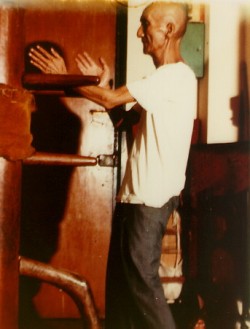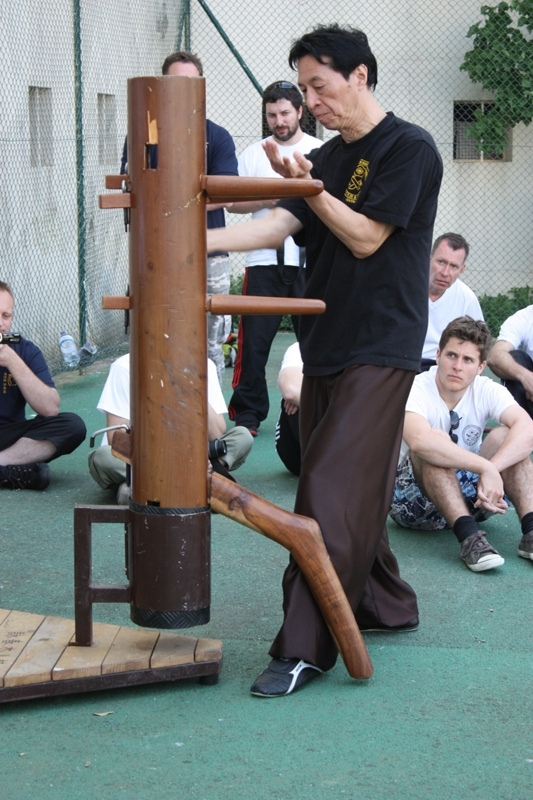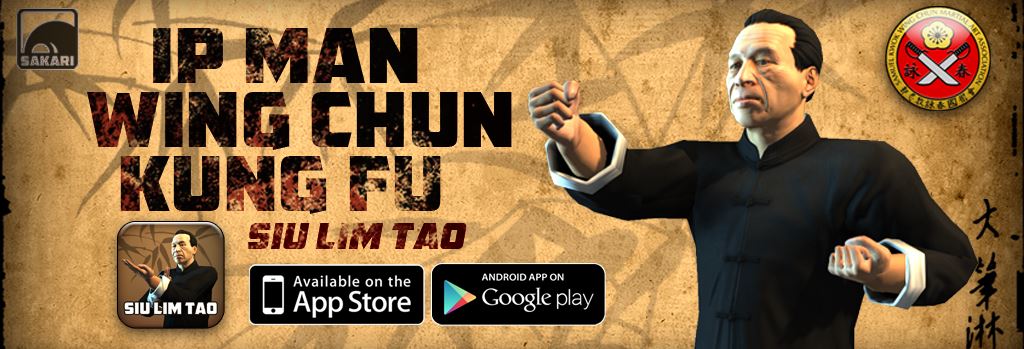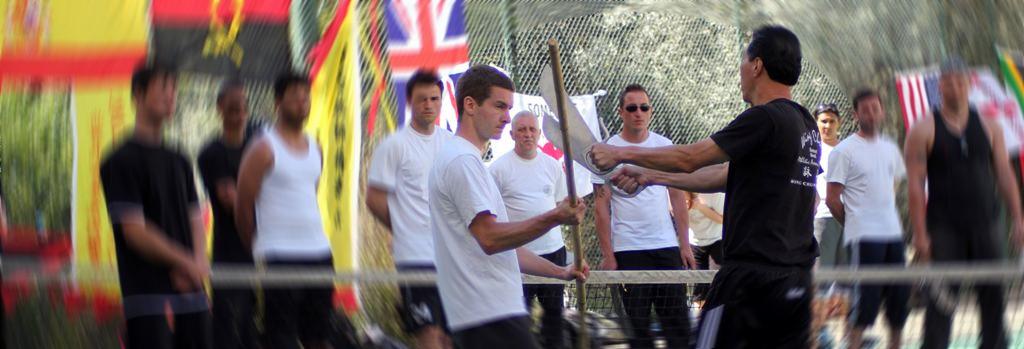Wing Chun Dummy Form
Article by Dan Knight added on 23 Jul 2012. Last updated on 12 Mar 2014.
Muk Yan Jong or Wooden Dummy Form
Perform the Mok Jong in the Air - Wing Chun Kuen Kuit
The history of the form
 Muk Yan Jong sometimes called Mok Yan Chong has 116 techniques that comprise the wooden dummy form as taught by the late grandmaster Ip Man. Originally the form Ip Man put together was 108 techniques but later more kicks were added. The idea of using a wooden dummy to practice techniques dates back to a time well before Ip Man. It is thought the idea of using a wooden dummy originated in the Shaolin Monasteries. Based on a number of versions of Wing Chun's history, the Shaolin Monks and Nuns played a key part in the early development of Wing Chun and can therefore be credited with the origin on the Wooden Dummy techniques in Wing Chun. However Ip Man did radically re-order the Wing Chun system, especially the dummy form. Therefore much of the Dummy form taught to day can be attributed to Ip Man. Although there are still a number of different ways of doing the form, as practiced by different lineages, Ip Man's system seems to be the most common.
Muk Yan Jong sometimes called Mok Yan Chong has 116 techniques that comprise the wooden dummy form as taught by the late grandmaster Ip Man. Originally the form Ip Man put together was 108 techniques but later more kicks were added. The idea of using a wooden dummy to practice techniques dates back to a time well before Ip Man. It is thought the idea of using a wooden dummy originated in the Shaolin Monasteries. Based on a number of versions of Wing Chun's history, the Shaolin Monks and Nuns played a key part in the early development of Wing Chun and can therefore be credited with the origin on the Wooden Dummy techniques in Wing Chun. However Ip Man did radically re-order the Wing Chun system, especially the dummy form. Therefore much of the Dummy form taught to day can be attributed to Ip Man. Although there are still a number of different ways of doing the form, as practiced by different lineages, Ip Man's system seems to be the most common.
Benefits of the wooden dummy form
 The form makes up an important part of the Wing Chun learning curve. The dummy form is often said to contain the fighting techniques of the Wing Chun system. This does not mean to say that the techniques learned in the 3 empty forms are not for fighting or combat, the difference is application. The empty hand forms have to be applied to a situation and cannot always be performed exactly as they appear in the form whereas the techniques in the Dummy form are performed against the 'Jong' or dummy, and therefore are being practiced in a way that applies them directly. This is because the techniques are performed against the physical arms, legs and body of the wooden dummy.
The form makes up an important part of the Wing Chun learning curve. The dummy form is often said to contain the fighting techniques of the Wing Chun system. This does not mean to say that the techniques learned in the 3 empty forms are not for fighting or combat, the difference is application. The empty hand forms have to be applied to a situation and cannot always be performed exactly as they appear in the form whereas the techniques in the Dummy form are performed against the 'Jong' or dummy, and therefore are being practiced in a way that applies them directly. This is because the techniques are performed against the physical arms, legs and body of the wooden dummy.
The advantages of training on a wooden dummy are, that it can be hit as hard as the practitioner wishes, it can be trained on for long hours whereas a live partner might get bored. Also as the Dummy does not move much, the practitioner learns mobility while circling around the dummy in conjunction with blocking and striking hand techniques.
The key benefits of training on a dummy are:
- Improves Yiu Ma (power from the waist)
- Teaches the student the correct distance
- Contains some additional techniques like kicks
- Forces good structure in techniques
There are also some ancillary benefits including:
- Conditioning of the hands and arms
- Helping the student practice applying Wing Chun
About the dummy itself
 The wooden dummy itself (sometimes called a wooden man) represents a physical opponent; its arms can represent attacks that have to be blocked or obstacles for the practitioner to overcome in order to attack the trunk of the dummy. The leg of the dummy has to be maneuvered around and attacked by the practitioner during the form.
The wooden dummy itself (sometimes called a wooden man) represents a physical opponent; its arms can represent attacks that have to be blocked or obstacles for the practitioner to overcome in order to attack the trunk of the dummy. The leg of the dummy has to be maneuvered around and attacked by the practitioner during the form.
The dummy form contains applications from the three hand forms, along with some additional techniques like the neck pull and some additional kicks. Because of the angle and structure of the Dummy, the trainee is naturally drawn to execute his/her techniques with correct positioning. Because the dummy is a solid object any mistakes in the practitioner's technique, like incorrect angle and position of block or wrong use of energy is easily identifiable. Mainly because it will result in a loss of balance or a clash of force causing pain and one mistake in the positioning of a block in the dummy form will often lead to the next move being harder to perform so eventually the positioning and use of energy becomes perfect from training on the dummy. A live partner on the other hand may not be able to identify mistakes if he/she is not experienced. In order for this to be the case there are a few key things to make sure of when selecting a wooden dummy:
- The top two arms must be parallel. One should not be higher than the other.
- The dummy leg should not come out too far. When in a stance from the dummy, the leg should end just before the practitioners toes.
- The top two arms must not be too far apart. This is essential your techniques are to be structurally sound. 150 - 200mm is a good distance, give or take.
Wooden Dummy Form Video
The Wing Chun Wooden Dummy form done by master Kwok is the same as that performed by Ip Man. The footage below demonstrates Grandmaster Kwok preserving Ip Man's Kung Fu in his DVD Mastering Wing Chun Volume 5.
Ip Man was performing the dummy form in 1972. We also have full footage of Ip Man performing the Mok Yang Jong on youtube.
Getting a Wooden Dummy
Build a dummy from plans
 We have put some plans for making a Wing Chun wooden dummy on our site. The wooden dummy plans were drawn up by James F. credit for the work goes to him. How to make your own Jong can be found on our Wooden Dummy Plans page.
We have put some plans for making a Wing Chun wooden dummy on our site. The wooden dummy plans were drawn up by James F. credit for the work goes to him. How to make your own Jong can be found on our Wooden Dummy Plans page.
Buy a wooden dummy on line
 The Kwok Wing Chun site now sell wooden dummies to people in the UK and Europe. These high quality wooden dummies take the practicality of a free standing dummy with some of the performance of a wall mounted one. Our hybrid dummy's are very good value for money as they are made in China and drop shipped out from the UK. So you could have you dummy in 2 days! Read more about the dummy.
The Kwok Wing Chun site now sell wooden dummies to people in the UK and Europe. These high quality wooden dummies take the practicality of a free standing dummy with some of the performance of a wall mounted one. Our hybrid dummy's are very good value for money as they are made in China and drop shipped out from the UK. So you could have you dummy in 2 days! Read more about the dummy.
Further Reading
Ip Ching on the Wooden Dummy
 In this shot Article Ip Ching talks about the Dummy form and there is a video of him snapping a dummy arm. Ip Ching Dummy Form Tips
In this shot Article Ip Ching talks about the Dummy form and there is a video of him snapping a dummy arm. Ip Ching Dummy Form Tips
Traditional Wooden Dummy: Ip Man's Wing Chun System
 This book by Sam Kwok is the latest installment in the Mastering Wing Chun Series and covers the dummy form and is designed to go with the Dummy DVD. This book is 128 pages long and covers the traditional Wing Chun Kung Fu wooden dummy form as taught by the late grandmaster Ip Man. This is ideal for more advanced students of the martial art.
This book by Sam Kwok is the latest installment in the Mastering Wing Chun Series and covers the dummy form and is designed to go with the Dummy DVD. This book is 128 pages long and covers the traditional Wing Chun Kung Fu wooden dummy form as taught by the late grandmaster Ip Man. This is ideal for more advanced students of the martial art.
Availible On Amazon
116 Wing Tsun Dummy Techniques Book by Ip Chun
 This book by Ip Chun, is one of the early Wing Chun books. The main focus of the book is the wooden dummy form and to this end it is a pretty handy book. Although some other areas are covered, unless your looking for a book about the dummy form this does not have a huge amount to offer. Having said that it's not an expensive book.
This book by Ip Chun, is one of the early Wing Chun books. The main focus of the book is the wooden dummy form and to this end it is a pretty handy book. Although some other areas are covered, unless your looking for a book about the dummy form this does not have a huge amount to offer. Having said that it's not an expensive book.
Availible On Amazon
Chong Woo Kwan Wing Chun
 The book Chong Woo Kwan Wing Chun: Art of Simultaneous Defence and Attack is a great book by author Joseph Cheung. Master Sam Kwok trained with Joseph many years back when learning under Lee Sing in the UK. This book focuses mainly on the Wing Chun wooden dummy form, and the various practical applications of the form. It's well written and well laid out.
The book Chong Woo Kwan Wing Chun: Art of Simultaneous Defence and Attack is a great book by author Joseph Cheung. Master Sam Kwok trained with Joseph many years back when learning under Lee Sing in the UK. This book focuses mainly on the Wing Chun wooden dummy form, and the various practical applications of the form. It's well written and well laid out.
Availible On Amazon
Tags for this article:
Wooden DummyWing Chun DummyMuk Yan JongForms



